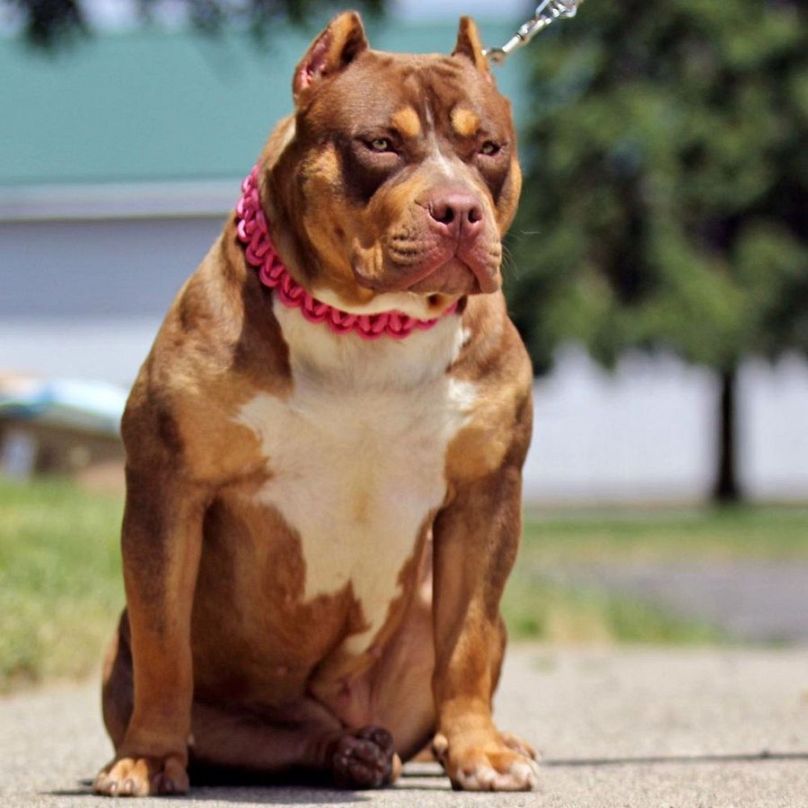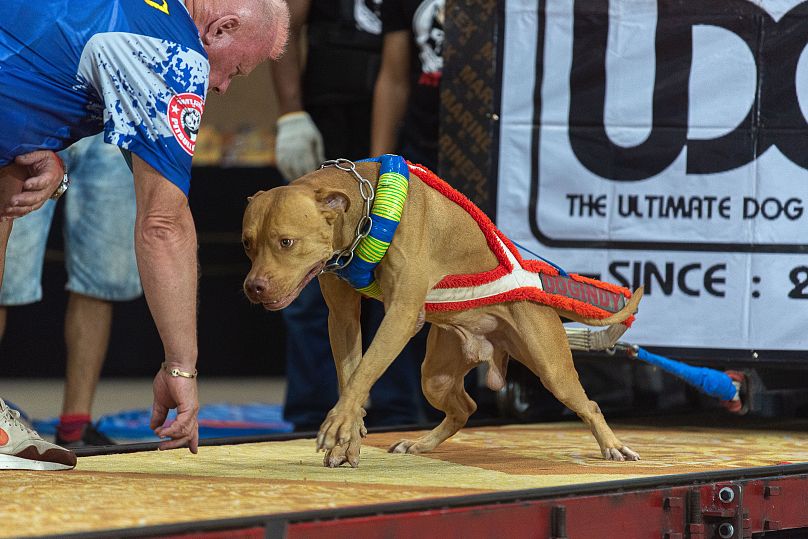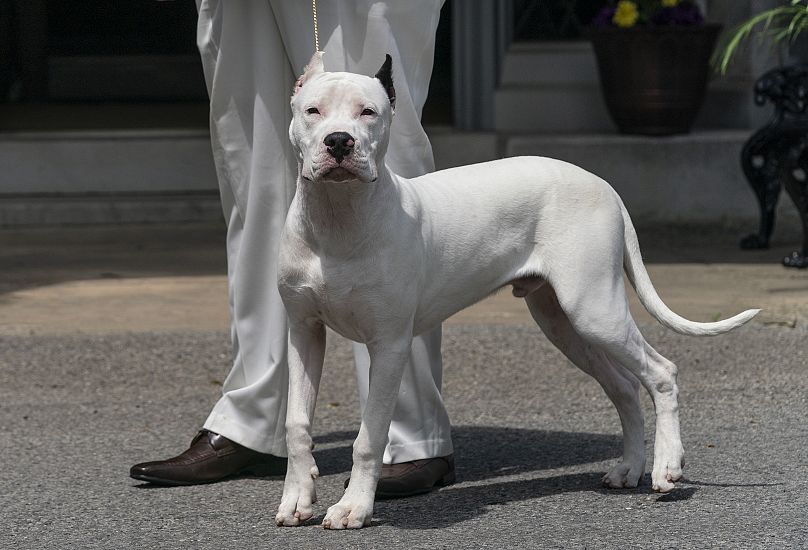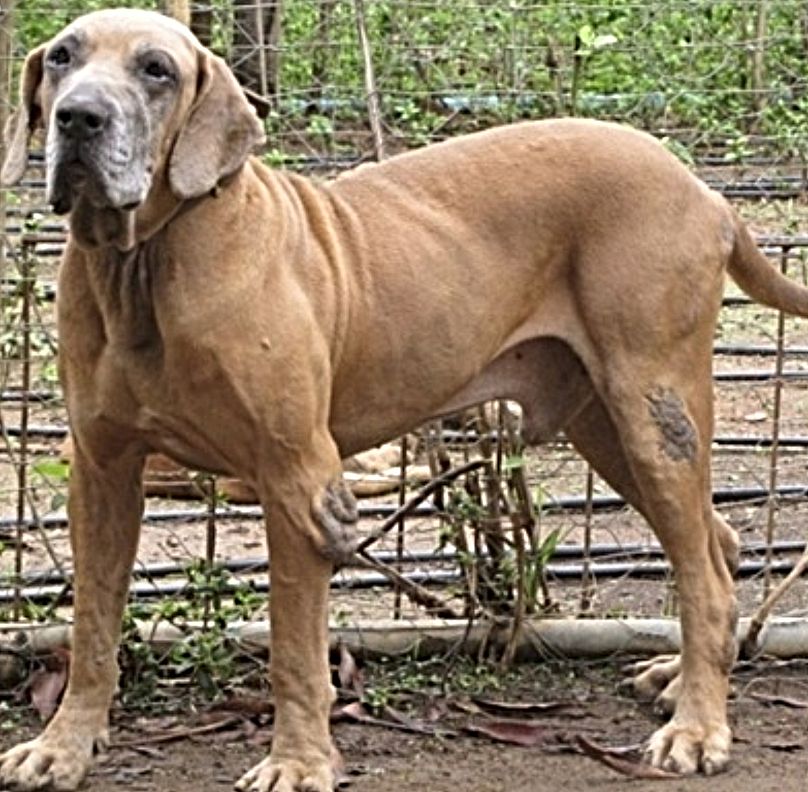On Friday, British Prime Minister Rishi Sunak announced the nation's intention to ban all American XL Bullies by the end of the year, following a recent spate of attacks - but which 'dangerous dog' breeds are the most outlawed across Europe?
After days of speculation, it’s been confirmed that the American XL Bully dog breed will be banned in the United Kingdom.
On Friday, Prime Minister Rishi Sunak announced that the dogs are a danger to communities and human life and vowed to take the breed off the streets.
The move comes a day after a man died in the Midlands after being savaged by two dogs.
They have previously attacked several other UK citizens, including a two-year-old child.
Sunak’s decision, while claiming he "shared the nation's horror" at such attacks, means that the Bully XLs will be prohibited by the end of 2023.
There won't, however, be a mass cull of the dogs. The UK's chief veterinary officer, Christine Middlemiss, announced on Saturday that there will instead be an "amnesty", where existing owners will have to register their dogs and take actions such as making them wear a muzzle in public.
In the UK, Bully XLs join four other breeds - the Pit Bull terrier, Japanese Tosa, Dogo Argentino and Fila Brasileiro - which are all banned under a law that prohibits any dog which is "dangerously out of control.”
Downing Street has been forced to deny that the government had taken too long to ban the Bully dogs.
A spokesman for No. 10 said: "Clearly this breed of dog isn't defined in law so it's right to take the time to consider the best way to put an end to these horrendous attacks that we're seeing".
There are concerns that the ban may not be as easy to enforce as many would hope.
The American bully XL is, in actual fact, not being recognised as an individual breed by the Kennel Club. That could mean the ban put in place against them may inadvertently outlaw other kinds of dogs.
In Parliament, there have been calls to overhaul the Dangerous Dogs Act - the law currently in place to prevent canine attacks - with a focus on specific traits as opposed to entire breeds or ‘types’.
The Act, put into law in 1991, has long been controversial for its failure to stem the rise of dog attacks and for its apparently misplaced focus on a dog's breed or appearance instead of an individual dog's behaviour.
On Thursday, former Conservative MP Baroness Fookes said: "I suggest that he should be more radical when looking at the Dangerous Dogs Act. It is time that that was sent to the knacker's yard and a new system instituted altogether”.
"I say this with some regret because I was the one who introduced it in the other place (the Commons) in the first place”, Fookes added.
Her comments come at the same time as those from former police chief Lord Hogan-Howe, who has called for a national amnesty to get such dangerous dogs off the streets.
In 2007, he introduced a similar measure following the death of five-year-old Ellie Lawrenson, who was mauled by a banned pit bull-type dog in Merseyside on New Year's Day.
The American XL Bully is a relatively new dog breed. Originating in the United States in the 1980s, it was initially a mix between the American pit bull terrier and American Staffordshire terrier, but has since been crossed with other breeds to create an ultra-muscular dog.
Known for its “instability” and “powerful appearance” the breed can weigh more than 60kg - and is capable of overpowering an adult.
In the UK, Bully Watch, a group that advocates for a ban on selling and breeding large Bullies, says American Bully XLs or American Bully Mixes have been responsible for a significant 38% of all dog attacks in the county so far this year.
They’re already illegal in France, Turkey and the United Arab Emirates; while in other countries including Ireland, there are strict rules in place that they must be muzzled and kept on a lead shorter than two metres when they’re in public.
The rules on dangerous dogs across Europe
Although the American Bully XL’s banning in the UK is likely to cause other European nations to follow suit, they’re not the most prohibited dog on the continent by a long shot.
That dubious honour goes to the Pit Bull.
Interestingly, it’s not a specific breed, with the colloquial term ‘pit bull’ used to encompass a wide variety of dogs.
While some professional breeders of the American Pit Bull Terrier have tried to get that particular type recognised as the only ‘true’ pit bull, they have failed on numerous occasions.
They’re prohibited in many countries across the globe - ranging from outright bans to restrictions and conditions on ownership.
Known as the top killer of children among all canines, they are banned or restricted in Denmark, France, Germany, Norway, Poland, Portugal, Romania, Spain, Switzerland and Turkey.
In the UK, it is entirely against the law to own, sell, abandon, give away, or breed any kind of Pit Bull Terrier.
The Japanese Tosa is subject to the same fate in the UK, where a specific exemption from a British court is required to own and import Tosas legally.
Originally bred in Japan as a fighting dog, it remains the only dog in that country that is still used - legally - in Japanese dog fighting.
In South Korea, it is one of the main breeds used for dog meat, but in Europe it’s banned in several nations due to its dangerous nature.
Austria, Denmark, France, Iceland, Romania, Malta, Norway and Turkey all have prohibitions or legal restrictions in place on the Tosa at a national level.
In the UK, it’s also illegal to own the Dogo Argentino breed without authority from the government.
Bred primarily from the extinct Cordoba fighting dog, it’s known as a big-game hunter as well as trainable in search and rescue and as service dogs.
While some countries value the Dogo, in Europe its often unsteady temperament is recognised as a serious fault.
Nations including Denmark, Norway, Iceland and Turkey have rules in place restricting ownership.
In Ukraine, too, which does not enforce bans or restrictions on dog breeds at a country level, the Dogo appears on the Ukrainian Kennel Club’s ‘dangerous dogs’ list.
Ukrainian laws allow specific regions to regulate particular breeds, allowing different cities and areas to decide on their own dog prohibitions.
The Fila Brasileiro is a Brazilian breed, known for centuries for its aggressive manner.
Often used as a guard dog and for big game hunting, it was notorious in the 18th century for being used by Brazilian slave owners to retrieve their escaped slaves.
Perhaps in part due to the verb "filar" in Portuguese literally meaning "to hold, arrest, grab", suggesting that the Fila is a dog that "bites and does not loosen its grip", as well as its exceptionally strong jaw, it is banned in several nations.
Likely to become very antisocial if not trained effectively, they are known to have killed smaller dogs and other animals as well as human beings.
Banned in the UK since 1991, Norway, Malta and Cyprus have followed suit in Europe, making it illegal to own the breed without specific exemption from a court. In Turkey, the rules are tougher still; there, it is illegal to own and breed a Fila Brasileiro at all.
In Europe, there are only two countries which don’t explicitly ban any dogs.
Finland is known as a dog-friendly nation which has no restrictions on importing or breeding any dog breed. It has put in place some rules and regulations around dog ownership though, namely that dogs must be kept on a lead and hybrid breeds of dogs with wolves are prohibited.
In Ireland, there are no laws against importing or breeding any kind of dog breed.
The country’s Dog Breed Specific Legislation, though, has restricted 11 dogs, including three types of pit bulls, Rottweiler, Alsatians and the Japanese Tosa.
Owners must follow prescribed rules, with those specific canines only allowed to be led by those over the age of 16.
Many of them are not permitted in public places without a lead and in others without a muzzle.
Are yearly dog attacks on the rise?
It’s estimated that around 100 million people across the globe are attacked by dogs on an annual basis.
While most incidents cause small injuries at worst, an increasing number of people have been severely hurt or killed by out-of-control dogs.
In England and Wales alone, it’s estimated that attacks have gone up by 34% in the last five years, despite the dog population rising by only 15% in that same time frame.
A 2016 study by Science Direct found that, between 1995 and 2016, the number of European fatalities due to dog attacks increased significantly year on year.
In 2016, 45 Europeans were killed by dogs, a figure which translates to an incidence of 0.009 per 100,000 inhabitants and means that, nearly once a week that year, a European was fatally wounded by a canine.
That number is still going up - and only Luxembourg has avoided fatalities at the hands of dangerous dogs since 1995.
From 1995 to 2016, the largest number of dog-inflicted deaths occurred in Hungary (94 fatalities), France (79), Romania (67), the UK (56) and Poland (49).
Finland, known for its relatively relaxed laws on dog ownership, saw 26 deaths in that period, a larger figure than the combined fatalities of the other Scandinavian nations, Denmark, Norway and Sweden, which recorded 23 killings.
While the ban on dangerous dogs often comes as a relief to many, it is not an exact science, with geographical areas varying hugely in terms of attack numbers.
Across the globe, as in Europe, socio-economic conditions have been found to be directly linked to the number of attacks, but experts say that a bad living situation clearly doesn’t make every dog more inclined to violence.
Despite Rishi Sunak telling the British public: "these dogs are dangerous, I want to reassure the public that we will take all necessary steps to keep people safe”, some critics are saying the ban on American Bully XLs is simply not enough - and that all dogs in the UK and Europe with even a hint of a violent breed history should be examined far more closely.




















